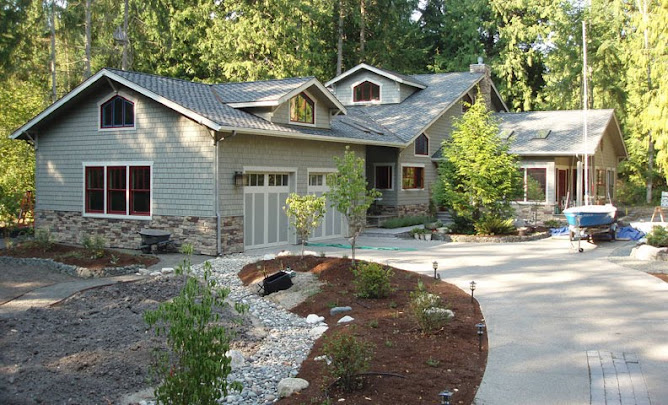Alas, Pex to the rescue. This plastic pipe has been about for about 30 years, and is used extensively in Europe. I think its introduction and acceptance in the USA has been impeded by the plumbers unions, mainly because its just too easy to install. Denver doesn't allow it, but the International Building Code (and Port Townsend) does. Whatever the reason, I'll leave the little bit of copper work we'll need to Bob Brown and do all the plastic piping my self. I started with the Pex on Wednesday (5 days ago) and had most of it done by Sunday evening.
We're running three main lines (i.e. zones). No. 1 is the hot water supply, which will be a closed, circulating loop. What I mean is that there will be a little pump & timer on the line that automatically circulates hot water every 10± minutes at the times of the day that hot water is used. For example, in our house hot water is used for showers in the am, for cooking (mainly dinner) and for laundry. Anyway, with hot water always in the main loop, any faucet is only 3-4 ft away and you should have fully hot water in 10-20 seconds. I used red Pex for this--makes sense (duh). What do you think about that, Mr. Sailboat? I know it takes 2 minutes (and wastes 3-4 gals of water) to get hot water to the shower next to Nancy's old bedroom in California (but you guys have way too much water anyway).

 The second line is the cold water supply, but only for non-drinking purposes (showers, laundry, toilets, etc). I used blue Pex for this. We've isolated this cold water to eventually accommodate a water softener or high-tech filtration system which we might need, but aren't sure. The third line is the cold water potable supply (kitchen sinks and outside hose bibs). I used white (clear) Pex for this. We don't want to drink softened water or put it on the yard plants. However if we get a filtration system, then we'll just replumb the two cold water lines together and all is well.
The second line is the cold water supply, but only for non-drinking purposes (showers, laundry, toilets, etc). I used blue Pex for this. We've isolated this cold water to eventually accommodate a water softener or high-tech filtration system which we might need, but aren't sure. The third line is the cold water potable supply (kitchen sinks and outside hose bibs). I used white (clear) Pex for this. We don't want to drink softened water or put it on the yard plants. However if we get a filtration system, then we'll just replumb the two cold water lines together and all is well.So there you go: Red, White and Blue plumbing—quite patriotic . It has a Steve Cooley feel to it.

Contrary to my preconceptions, the domestic water part of the plumbing is way easier than the hard pipe waste and vent plumbing. The Pex flexs and can make gentle bends: you can bend the 1/2" Pex into a radius of about 4" and 8" for the 3/4" Pex. So you can snake it into and out of walls and floor joists and only need to drill holes about 1" in diameter, which you're permitted to do anywhere in an engineered joist. I have a variety of little plastic fittings such as elbows, tees, and connectors. You can have three 1/2" lines off a 3/4" line, so most bathrooms have a 3/4" line the passes beneath it with the shower, and vanity and toilet coming off that line.
 The only ringer in this process is the Pex expander tool. This device (see picture of blue box) is used to expand the pipe so the fittings will fit. You put a collar on the pipe, and insert the expander and start pumping. It felt like I'd been to the gym when I got home the first day. Most homeowners would never have one becasuse they aren't for rent (only sold to Pex certified installers). But after installing 2,200 ft of Pex in the Warmboard, I felt pretty qualified so I ordered one from Pex Supply. After I'm done with the house, I plan is to sell it after to my radiant heating guy (Levi Ross, with lifetime occasional-use clause) or on Craigslist. It was $300 new, so if I get $150-$200 for it I'm way ahead.
The only ringer in this process is the Pex expander tool. This device (see picture of blue box) is used to expand the pipe so the fittings will fit. You put a collar on the pipe, and insert the expander and start pumping. It felt like I'd been to the gym when I got home the first day. Most homeowners would never have one becasuse they aren't for rent (only sold to Pex certified installers). But after installing 2,200 ft of Pex in the Warmboard, I felt pretty qualified so I ordered one from Pex Supply. After I'm done with the house, I plan is to sell it after to my radiant heating guy (Levi Ross, with lifetime occasional-use clause) or on Craigslist. It was $300 new, so if I get $150-$200 for it I'm way ahead.

